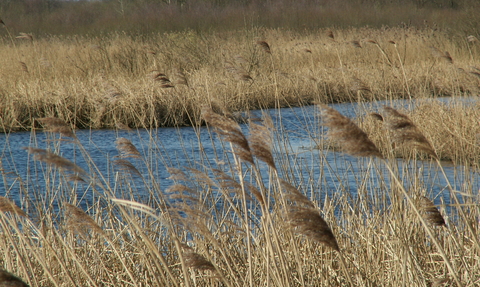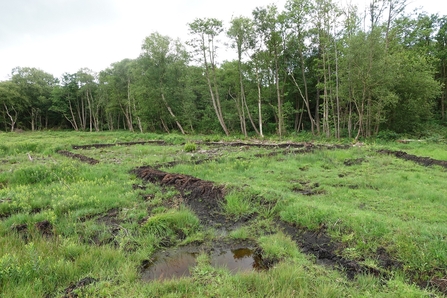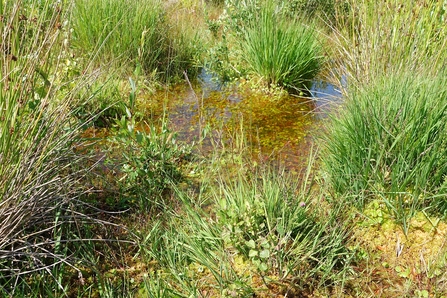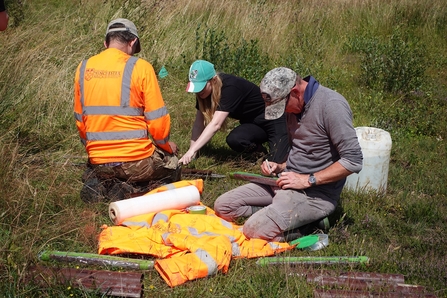
Mark Blake
Westhay Moor's restoration project: FAQ
Your questions answered
Somerset Wildlife Trust will be carrying out peat restoration work at Westhay Moor National Nature Reserve. The work is being funded by the Nature for Climate Peatland Grant Scheme which is administered by Natural England on behalf of Defra.
Understanding Peatland Restoration
What is Peatland Restoration?
Peatland restoration is the process of re-wetting a degraded peatland so that it starts to function more naturally and can support typical peatland wildlife. Restoring a site’s hydrology also helps to control emissions of greenhouse gases like carbon dioxide.
What does Climate Change have to do with peatland restoration?
We can’t hold back climate change! Peat is made from partially decomposed plant material that fell into waterlogged conditions, these conditions slow and halt the decomposition process and ultimately lock up carbon in that plant matter for thousands of years. By draining peatland these natural decomposition processes re-start. As peat is made from organic matter it shrinks and wastes away being released as carbon to the atmosphere adding to the climate crisis. By stopping the processes which are drying out the peat, like evapotranspiration by trees and scrub, and re-wetting the site we will stop the peatland disappearing from beneath our feet.
A healthy functioning peat bog with the right hydrology and presence of peatland species like sphagnum moss is more resilient to climate change. Sphagnum has superpowers - it can hold up to 20 times its own weight in water, which once fully re-established across the surface of a bog, like the mire at Westhay Moor, will actually help to keep the surface of the peat wet during long, hot dry summers and keep the carbon stored within the peat safely locked away.
So, we need to re-imagine the purpose of our nature reserves - as havens for wildlife yes, but also as stepping stones towards building a more adaptive, and climate-resilient nature recovery network that supports the safe passage of species when they also adapt in line and move to create new populations.
Doesn’t re-wetting peat cause more methane to be released?
Re-wetting peatlands does result in a temporary increase in methane emissions, but it has been shown that re-wetting still has a long-term cooling effect on the climate because the methane emitted only stays in the atmosphere for 12-15years, whereas the carbon dioxide emissions without re-wetting would have warmed the atmosphere for centuries.
Does digging into the peat release greenhouse gases?
There will be some release of greenhouse gases as a result of digging into the peat, as methane and carbon dioxide “bubbles” within the profile are disturbed and released to atmosphere. The peat, however, is not dug out and left to dry, but is instead put back into the ground and compacted within a short space of time (not more than 1-2hours). Whereas the carbon dioxide emissions without re-wetting the site would have warmed the atmosphere for centuries.

The result of Shapwick Heath's cell bunding peat restoration work, 2023. Photo: Alison Hoare
Planned activity at Westhay Moor
When will the work be taking place?
We will be carrying out these restoration works over two ‘restoration seasons’ in autumn/winter of both 2023/24 and 2024/25.
Why are we restoring the peat at Westhay Moor?
Somerset Wildlife Trust has undertaken a lot of work at Westhay over the decades. Initially to restore it post hand cutting and protect the site from the damage being caused by industrial peat mining immediately adjacent and, more recently, to raise water levels in the lakes and reedbeds around the site. However, from the water level monitoring data we have it is evident that the rain that falls on the site isn’t retained within the peat and flows away far too quickly which is putting this amazing habitat at risk.
With changes in weather patterns and climate change, this problem will only get worse and means that our ‘business as usual’ activity will not be sufficient to keep the peat wet without taking more drastic, adaptive action. These restoration works will slow the flow of water within the peatland, preserve the ancient carbon stored within it, and ensure that the rare and specialist plant, invertebrate and animal communities associated with peatlands have a home in the heart of Somerset for the long term.
How do we know the hydrology at Westhay Moor needs fixing?
On the surface we have a number of indicator species that show us that the peat soils are drying out – the presence of birch scrub, bracken, gorse and brambles which our Reserves Team and volunteers clear each year shows us that the hydrology is not what it should be. In some areas things are going well where we have sphagnum, sundew, micro plume moth and the large marsh grass hopper but these tend to be in isolated pockets rather than large swathes of the site.
In a healthy peat bog groundwater level could be expected to be within 10cm of the ground surface all year round. At Westhay Moor in the summer months water levels can be up to 75-80cm below the surface, and although higher in winter are still very reactive to rainfall events.
Is Westhay Moor emitting greenhouse gases at the moment?
Yes, Westhay Moor is emitting greenhouse gases. From measurements made by Somerset Wildlife Trust in 2022 the site is releasing both carbon dioxide and methane in greater quantities than might be expected of a functioning, wet ‘boggy’ peatland (which through microbial activity does emit some greenhouse gases).
What about the trees you are taking down?
In the right place trees provide important habitats and are great carbon stores. But trees and scrub are not found on open healthy peat bogs or fens. To restore peatland trees and scrub need to be removed as through processes like evapotranspiration and intercepting rainfall they are making the peat dry out, releasing the carbon stored and putting the open bog sphagnum, sundews and cotton grass present at risk. This may seem counter to the dominant narrative around trees and climate change, but in the context of our struggling peatland bog, trees do more harm than good. A one metre depth of peat holds three times the carbon of a tropical rainforest in the same area, so the capacity of the trees to sequester carbon on the site is far outweighed by the damage they do in exacerbating the drainage of the peat.
Prior to drainage Westhay Moor would have been an open habitat with no trees present. We are restoring the peat at Westhay as peat is by far the best carbon store in terms of habitat type. The carbon stored within the peat is thousands of years old.
In re-establishing an open habitat it will also provide greater opportunity for ground nesting birds like the Lapwing to nest safely, without vantage points for predators nearby. In January 2023 similar restoration works were undertaken at our Avalon Marshes partner site Shapwick Heath which had its first pair of nesting Lapwing in that part of the site for a very long time which is a great news only months after the works have taken place.
How will this work affect the existing species at Westhay?
Through the consents issued by Natural England, works are timed to take place outside the bird nesting season and have been considered in terms of potential disturbance to over-wintering birds. For a number of the specialist peatland species we have at the site, these works should help to ensure the longer term survival of the likes of micro plume moth, bog bush cricket and large marsh grasshopper.
With regard to adders specifically, they have moved into some parts of the site as conditions have become less boggy and more heath-like. Through this project we are providing adder hibernacula close to areas where adders have been spotted in locations where we anticipate the ground will stay drier after the re-wetting works.
Will Westhay Moor close while the work is being done?
Westhay Moor will still be open to the public whilst the works are being carried out. There may be a few areas where footpaths through the reserve will be closed or have a diversion around, but these will be relatively short lived as contractors progress around the site.
The pathway around the Mire will have to be closed as part of these works. As the re-wetting process really takes hold, conditions underfoot are likely to become increasingly dangerous. In time an alternative pathway route along the eastern edge of the mire will be opened up to allow views across the restored mire area.
Are there any risks to visitors while the work is being done?
Provided visitors to the Reserve stick to the designated walkways and follow any safety signage, instructions and barriers that are in place, there will be no risks to visitors.

Photo: Alison Hoare
Your technical questions answered...
What restoration techniques will you be using to restore the peat at Westhay Moor and why?
There are several restoration techniques that we will be using:
Vegetation management:
In selected areas, larger vegetation like trees, scrub and non-bog species like brambles and bracken will be removed to recreate the open habitat that is synonymous with lowland raised bogs. The scrub and the bracken will be mulched (shredded or chipped) and left on the site, to provide cover from wind for bog species like sphagnum to grow and protect it from the frost before it becomes fully established.
We will be working with specialists to survey for bats and will leave some larger trees in. We also plan to create dead standing timber which will be great for invertebrates and, in combination with the some of the larger trees that will be left, we hope to provide some great feeding corridors for bats.
Restoring hydrological function - deep trench bunding and ditch blocking
Hydrology and slowing the flow of water is key in peatland restoration and, given the depth of the peat, deep trench bunding is an essential part of restoration as it allows the hydrological function of the peat to be restored. In degraded peatlands subsurface water loss is a major issue preventing the peat from sucking in and holding water, instead the water runs straight out. Using existing healthy peat from the site, deep trench bunds are used to seal these seeps, cracks and water loss features below the surface to keep the water in and importantly topped up by rainfall as the peat bog would have been thousands of years ago.
On the surface low level bunds of around 30-40cm are made to help retain the rainwater, even in areas where the peat has dried out and allows water to run off, the bunds will help reduce surface water flow and will retain rainwater making great conditions for bog pecies to become established / expand where they are already present.
This technique has been honed over the last few decades in the North of England and is only the second time this approach has been applied in lowland Somerset - the first project of its type being carried out on one of our Avalon Marshes partners’ sites - Shapwick Heath.
Where we have larger, deeper drainage channels within the restoration areas, these will be infilled slightly to reduce the depth and in places blocked to reduce the flow of water. This will help block up any of the deeper water loss features that might be draining the peat straight into the ditches and will buffer and water flow within the restoration areas.
Planting peat forming species
Once the hydrology works are complete we hope in places to boost the types of peatland species present on the site and give the restoration works the best possible start.
In the two northern restoration areas the objectives are fen creation given that the areas have been used for agriculture in the recent past and the soils are a little richer than are present in the southern restoration areas. We plan to use fen species including sphagnum mosses, grasses and sedges.
The areas to the south aim to restore the lowland raised bog communities which will include planting more sphagnum, including some peat forming species which are particularly rare at the site. All of the plants and mosses that will be used as part of the project will be grown peat-free by specialist nurseries.
Why are different peat restoration methods applied at different sites on the Avalon Marshes?
The Avalon Marshes is a mosaic of farmland, natures reserves, peat extraction and human settlement. There are differing habitats, different land management techniques and different types of farming systems all mixed together. This is all within a landscape containing a complex engineered system of rhynes, ditches and drainage channels, which are managed to minimise risk of flooding in winter and provide water supply in summer.
Further to this, landowners can also have very different restoration objectives for individual sites such as nature conservation, or species introduction, targeted connectivity, protection of carbon stores, or nutrient reduction etc. So the context of the site within the landscape, the historic landuse and the restoration objectives can be very site specific and will determine which restoration techniques are used on any given site.
For example, Honeygar Farm was formerly intensively grazed, nutrient levels are high, and the peat soils degraded through ploughing, field drains and long-term drainage to allow longer periods for grazing. Somerset Wildlife Trust’s objectives for the site are to become a Wilder Carbon site and a stepping stone in the Nature Recovery Network. The approach is focused on minimal intervention and allowing nature to wild the site.
Parts of the Westhay Moor reserve have been drained and the peat fully extracted. These areas have been restored to reedbeds and host amazing species like the bittern, marsh harrier and great white egret. However other parts of the site where 2-3m of peat still remain, have never been farmed so conditions are low nutrient and still very much typical of a lowland raised bog – albeit one which has been modified by human intervention. Here the objectives are to: remove damaging non-peatland vegetation, restore the hydrology of the site and to lock away the ancient carbon stored within the peat.
When will we know if the project has been a success and is making a difference?
Initially after the vegetation management and re-wetting works are done in the autumn/winter months, as we’ve seen at our partner site Shapwick Heath, we expect the site to quickly start ‘greening-up’ again as the new plant growth begins again in Spring.
Over the next few years we will be monitoring the water levels in order to see how the site is responding to the re-wetting works. With time water levels become less reactive to rainfall events and rise closer to the surface. The plant communities present will also be monitored to see how they shift and change with time – hopefully towards the anticipated peatland communities.
Whilst the hydrology of the site does settle we are anticipating that we will still have to do some scrub cutting work to keep the more stubborn bits from growing back too vigorously in the early years. However, in the fullness of time we anticipate that conditions will be too wet for the birch, bracken and gorse that have been drying out the peat.
Evidence from other peatland restoration projects from around the country has shown that it takes about three years for the degraded peat system to hydrologically ‘recharge’. So, the kinds of vegetation that shouldn’t be on a bog will become weaker and stop regenerating and the mosses and other peatland species given the opportunity to truly thrive.
How long before peat starts to form again?
It will take a number of years for the site’s hydrology and also the vegetation communities to shift to peat forming habitat. Needless to say we will be monitoring this shift very closely. If conditions are just right, peat forms incredibly slowly at a rate of just 1mm a year.
What about archaeology and the historic environment?
Peatlands are amazing at preserving organic archaeology and a record of the historic environment as they are by their very nature organic and waterlogged themselves. We have been working with our friends at the South West Heritage Trust to understand what the likelihood is for archaeological finds at the site and the potential is low, given what is known about the ancient trackways that would have crossed the area.
However, that doesn’t mean that there might not be any finds through the project so before starting the hydrological works at the site our contractors have taken part in a talk about the historic environment, what to look out for and what to do if they come across something that might be a piece of archaeology.
Will there be enough water once the works are complete?
Given climate change and the more extreme weather events we are experiencing we do expect rainfall to become more erratic and there may be future changes in the wider hydrological system that are beyond our control, but there is not enough concern to prevent the project moving forward. With more irregular rainfall patterns and storm events in coming years this strengthens the case for peat restoration. When peat is in good condition it acts like a sponge, sucking up water and holding on to it for a long time. Imagine a neglected house plant where the compost has gone hard and shrunk away from the edges of the pot. It takes a bit of time standing that pot plant in water before the (peat free!) compost can regain its full absorbent capacity.
So, in doing these works we will be making the system more resilient to changing weather patterns so the ‘do nothing in case there isn’t enough water’ option is not really a valid argument. The current issue is not that we don’t have enough water but that we have such effective drainage in place, the site can’t hold on to the water.

Identifying changes in the physical landscape and environment through time, using a hand-operated geoarchaeological borehole drilling technique. ARCA is a geoarchaeological consultancy based at the University of Winchester. Photo: Alison Hoare
